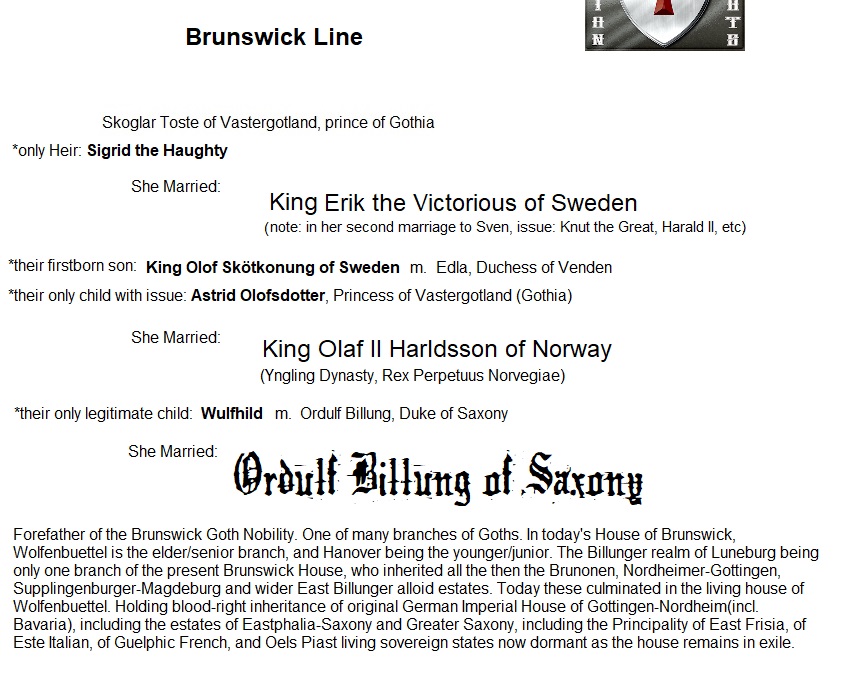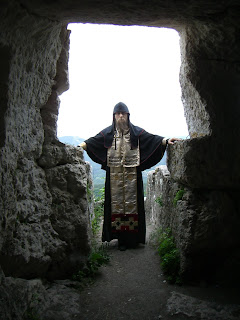The House of Wolfenbuttel-Brunswick Being a Legal Successor to Numerous States of the Goths’ Empire.
SPIS TREŚCI
- Następcy Billaungów, jako książęta i cesarze Niemieckiej Saksonii (Królewski Dom OSTROGOTÓW)
- GUELPH LINE OF OSTROGOTH HEIRSHIP
- ESTE LINE OF OSTROGOTH HEIRSHIP
- TYTUŁ KSIĘCIA GUTINGI (GOTTINGEN) STAŁ SIĘ TYTUŁEM DOMU DOMU ESTE-GUELPH BRUNSWICK
- Potomek królewskości Gothii na ziemiach turkusowych HISZPANII I FRANCJI (TERAZ LANGUDOK)
- TOULOSE VISIGOTH HEIRSHIP. MULTIPLE LINES OF GOTHS’ STATE SUCCESSORS WERE UNITED IN OTTO IV, THE DUKE OF BRUNSWICK, WHO WAS CROWNED EMPEROR OF THE HOLY ROMAN EMPIRE
- MATKA WSZYSTKICH KRÓLÓW FRANCUSKICH, ARGOTTA I WCZESNEGO ODDZIAŁU GUELFÓW (BRUNSWICK SENIOR BRANCH)
- SZWEDZKI I DUŃSKI DOM GOTII
- SUKCESJA GOTYKA I SUKCESJA IMPERIALNA
- YNGLING-GOTH DYNASTIC HEIRS
- CIĄGŁA OCHRONA KRYMSKIEJ GOTII
- KIEV-RUS GOTH DYNASTIC HEIRSHIP
- ROYALTY OF HUNGARIAN GOTH ESTATES, AS PIAST & POLAND-LITHUANIAN SUCCESSORS
- HISTORICAL AND NEW DYNASTIC CHARTS OF THE HOUSE OF WOLFENBUTTEL-BRUNSWICK
- PRINCE STEPHEN, ANOINTED AS A KING(of one jurisdiction) OF THE GOTHS FOR THE AOCC ARCHDIOCESE OF BERLIN, CONSECRATION CEREMONY IN 2015
- DNA Match of the Royal Capetian Line of Nott-Brunswick
Następcy BILLUNGS
Dziś najbardziej renomowana rodzina następców Domu im Amalings (leading dynasty of the Goths), the Royal House of the Ostrogoths of Italy, is most widely known as the Billungs. This house will be demonstrated in addition to a few other kindred houses which have held and continue to hold these estates. The primogeniture family successors of these Gothian houses is demonstrated herein. It is a long established fact of history as being realized in the House of Este-Guelph (head Dynastic Branch being Princes of Wolfenbuettel). The genealogy of the Billung’s successors are found below.

W 1137 roku kontrola Saksonii przeszła na dynastię Guelph, potomków Wulfhild Billung, najstarszej córki ostatniego księcia Billung, cesarza Lothara III z Supplinburga. Który przeszedł na jego cesarskiego następcę Henryka Dumnego, Henryka Lwa z Brunszwiku i jego syna cesarza Ottona IV z Brunszwiku. Brunszwik jest najstarszym żyjącym domem królewskim (i cesarskim) w Europie w świetle prawa międzynarodowego (choć de iure i wygnany, Brunswick-Wolfenbuettel obowiązuje w międzynarodowym prawie nakazowym).
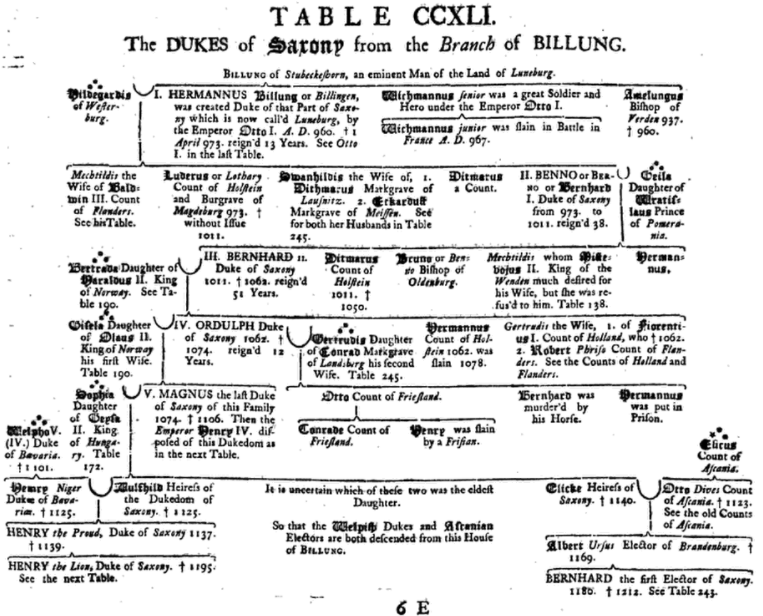
Hermannus Billung z Saksonii jest bezpośrednim męskim następcą Hengista, Witukinda i Gautiego.
 Od czasów Hengista, Saksonii, króla Kentu, jego syn Aesc był królem Kentu, podobnie jak jego syn Ochta i jego syn Eormenric, jego syn Saint Ethelbert I, jego syn Aethelbert i jego syn Eadbald , i jego syn Eormenred z Saksonii, wszyscy byli królami Kentu w Anglii. Miał syna, syna Aethelberhta, który pozostał lordem w Saksonii, a jego synem również grafem w Saksonii był Billung von Wenden, według jednej relacji. W innych relacjach Aethelbert II był królem synów Kentu, którzy powrócili do Saksonii, znanym jako Billings (Billungs) Saksonii. Większość genealogii sięga przynajmniej do „Brunharta Billunga I. von Stubenskorn Graf in Sachsen”, hrabia Turyngii był synem Aethelbertem. Bratem tego Bruno I był Amelung I Billung (którego linie są udokumentowane aż do roku 1137, kiedy wymarły, a ich ostatnia dziedziczka żeńska poślubiła męskiego spadkobiercę d'Este-Guelph (z Brunszwiku). Billings kontrolował Northmark pod Wichman the Elder. Nasza główna gałąź Billungs kontrolowała Northern Billunger March. Razem były to rozległe obszary. Amelung I był ojcem Bennida I Billunga, który był ojcem Amelunga II Billunga, który spłodził Amelunga III Billunga, który nie miał spadkobierców w 9th stulecie. Następnie linia ciągnęła się dalej przez Bruno, jak poniżej, aż do Henryka Leo (Lwa) z Brunszwiku i jego syna cesarza Ottona IV von Brunswicka oraz żyjących dziś następców prawnych.
Od czasów Hengista, Saksonii, króla Kentu, jego syn Aesc był królem Kentu, podobnie jak jego syn Ochta i jego syn Eormenric, jego syn Saint Ethelbert I, jego syn Aethelbert i jego syn Eadbald , i jego syn Eormenred z Saksonii, wszyscy byli królami Kentu w Anglii. Miał syna, syna Aethelberhta, który pozostał lordem w Saksonii, a jego synem również grafem w Saksonii był Billung von Wenden, według jednej relacji. W innych relacjach Aethelbert II był królem synów Kentu, którzy powrócili do Saksonii, znanym jako Billings (Billungs) Saksonii. Większość genealogii sięga przynajmniej do „Brunharta Billunga I. von Stubenskorn Graf in Sachsen”, hrabia Turyngii był synem Aethelbertem. Bratem tego Bruno I był Amelung I Billung (którego linie są udokumentowane aż do roku 1137, kiedy wymarły, a ich ostatnia dziedziczka żeńska poślubiła męskiego spadkobiercę d'Este-Guelph (z Brunszwiku). Billings kontrolował Northmark pod Wichman the Elder. Nasza główna gałąź Billungs kontrolowała Northern Billunger March. Razem były to rozległe obszary. Amelung I był ojcem Bennida I Billunga, który był ojcem Amelunga II Billunga, który spłodził Amelunga III Billunga, który nie miał spadkobierców w 9th stulecie. Następnie linia ciągnęła się dalej przez Bruno, jak poniżej, aż do Henryka Leo (Lwa) z Brunszwiku i jego syna cesarza Ottona IV von Brunswicka oraz żyjących dziś następców prawnych.
Herb Brunszwik Welfen (około 1200) z grobu Welfs VI. i Welfs VII. w St. Johannes Baptist (Steingaden); pierwotnie: niebieski lew na złotym tle (dziś w Bawarskim Muzeum Narodowym w Monachium). Helmzier, dwa rogi bawołów ozdobione pawimi piórami, zostały przekazane Welfen w Braunschweig od 1290 roku, a później staną się dzisiejszymi sierpami. Herb panów z Ravensburg (Beienburg) w herbie Zurychu, którzy byli na służbie Welf Henryka Lwa, przedstawia zarówno lwa (stojącego), jak i rogi bawołów ozdobione pawimi piórami.
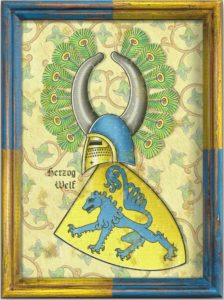
Poniżej znajdują się główne aloidy (posiadłości dziedziczne) wymienione jako ich dziedzictwo genealogiczne, aż do głównych linii dzisiejszych w Brunszwiku-Wolfenbuettel. Jest pokazany wraz z przechodzącym księstwem Getyngi (w tym Saksonią przez Henryka Lwa itp.).
(Note: 1. Gottingen was spelled Swedish Gutingi in the oldest documents. 2. The Gottingen alloid being from Woden-born Emperor Witekind (Saxony Dynasty) to his wife Geva, the daughter of the Haithabu King Gotterick of Denmark, the King of the primary realm called Gothia at that time in Scandinavia.)

Na linii Brunoidów można zobaczyć, jak doszło do przodka Brunszwiku, cesarza Lothaire'a, i innych cesarzy saksońskich rodziny.
Brunoidzi byli także książętami Fryzji. Ich królestwo z tamtych czasów (około 900 roku n.e.) używało Run na swoich monetach, ze starszej wersji Starszego Futharka. Oto jedna moneta z tego okresu:
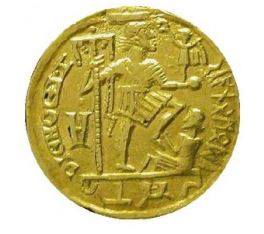
Więcej o saksońskich runach niemieckich można znaleźć pod adresem: http://orthodoxchurch.nl/2020/04/hundreds-of-older-german-runes-demonstrate-the-scythian-goth-kinship-in-viking-and-saxon-nations-directly-linked-to-wolfenbuettel-brunswick/
Wykres domu:
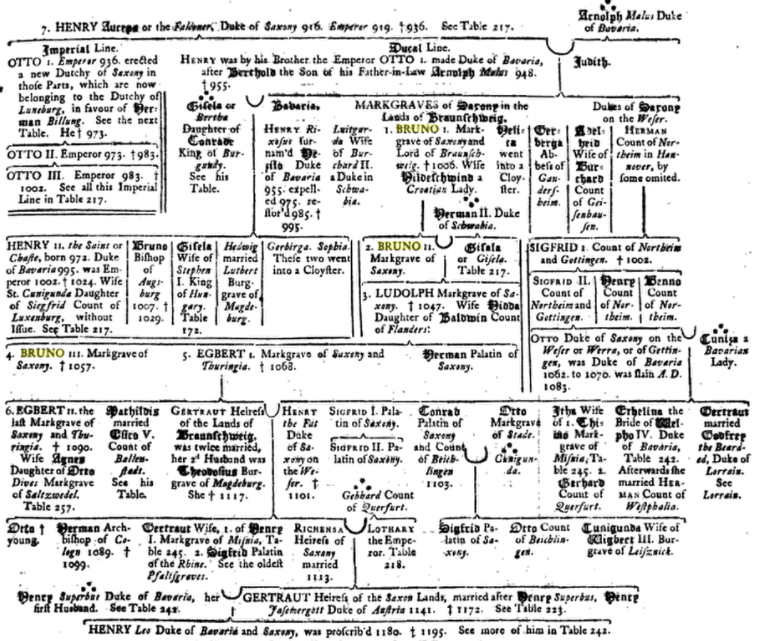
Jak widać (powyżej) Na wykresach genealogicznych Butlera, Göttingen jest również wymienne z Saksonią nad Wezerą, a także z Nordheim.
| Billunger Imperial Dynasty (Kings of Vendi, Dukes of Billunger March, Nordmark and Ostmark, Dukes of all Saxony, Emperors) |
| Wislaus III, first King of the Vendi (Vandals) and Oborites. (father of 14 successive Kings of the Wends) at the Baltic. |
| Aribert I, second King of the Vendi (Vandals) and Oborites Father of King Aribert II, King of the Wends. |
| Brunhart Billung I. von Stubenskorn Count in Saxony, Woden-born, Count of Thuringa, Prince of Kent. Was second-born son of Aribert. |
| Billung von Wenden, brother of Amelung, princeps militiae, Duke of Saxony |
| Amelung III Billung, Marshal of Saxony, Duke Luneburg / Billunger March |
| Ordulf Billung, Duke of N E Saxony (Billunger March Pomerania / Poland region) + Wulfhild of Gothia, Sweden and Norway |
| Wulfhild Billunger of Saxony. Eldest dau of Magnus, Heiress of the Dukedom Saxony + Elector Henry the Black d’Este-Guelph, Duke of Bavaria |
| Emperor Henry the Proud of Brunswick, inherited senior male estates of Guelph and ruled from the Baltic to Sicily. His duchy of Saxony alone was larger than half of Germany. The pope cancelled his Imperial election for Conrad. |
| Henry the Lion of Brunswick, Heir of all Imperial estates at 10 years old. Fully occupied Wends lands and took control. Henry’s daughter Mechtild married the senior king of the Wends, to give back some Wends lands to form the Mecklenburg house. |
| Emperor Otto IV, Duke of Brunswick, King of Germany, Crowned Holy Roman Emperor |
| Otto the Child, successor of Brunswick, in Denmark was made count of Garding and Thetesbüll in Schleswig Holstein as a Danish prince through his mother Helena Regent, princess and duchess + Ascanian Mechtild/Matilda of Brandenburg, of the Billunger line via Elicke, the younger dau of Magnus Billung and the Ascanian Counts |
| Emperor Frederick I Duke of Wolfenbüttel-Brunswick, Crowned King of Germany, Holy Roman Emperor, he and his brothers re-took Brandenburg per the Billunger and Ascanian rights |
| Duke August the Younger, although was last in line of succession to Wolfenbüttel -Brunswick because his mother Ursula was Ascanian dau of Duke Francis I of Saxe-Lauenburg + Elisabeth Sophie of Mecklenburg(Vendi) whose heir Ferdinand Albert received the seconditure of Bevern- Wolfenbüttel |
| Wolfenbüttel Mini-Emperors. The ‘elder-branch’ Successors continually Emperors of states across the continent with continued Military rank higher than Emperor as Commander-in-Chief of Prussia, Austria, Poland, France, Senior branch over Hanover etc. Cont’d claim of estates linked with the “greater domains”. |
GUELPH LINE OF OSTROGOTH HEIRSHIP
| Guelph Imperial Dynasty
(Princes of Scyrii, Kings of Italy, of Burgundy, and of Lombardia, Counts of Genoa, incl Genovese Crimean Gothia, and Altdorf in Swabia, Margraves of Milan, Dukes of Bavaria, Carinthia, and other Italian Ostrogothic estates) |
| Pharamond, King of Sicambrian Franks + Princess Argotta dau of Emperor Theodoric of Gothia and Italy |
| Edico, King of the Scyri, Herulii and Rugii, father of Odoacre |
| Arnoldus, of Franks, G.father of Charlemagne & Carolingian Emperors |
| Ruthardus of Altdorf, father of Guelph I of Bavaria |
| Adalbert III di Lucca (Margrave) of Tuscany |
| Gerberga of Burgundy, ancestress of Hohenstaufen, her mother was 6th G granddaughter of Charlemagne, father was Guelph Conrad King of Burgundy |
| Cunigunda, Heiress dau of Guelph II + Azo II of Mlian, became Marquess of Este 11K mansi of land of Elisina Lombardy + Azo Prince of Este |
| Guelph III, brother of Cunigunda Duke of Carinthia and Marqis of Verona incl Tyrol & Rhoetian Alps |
| Rudolf II, Count of Altorf and Ravensburg. (Some Pre-Charlemagne alloidial estates) |
| Guelph IV Duke of Bavaria, sone of Azzo II and Cunigunda of Altorf Swabian Elder line of Guelph |
| Guelph V + Mathilda Este heiress of all estates. Passed to his Elder brother, Henry the Black of Brunswick |
| Guelph VI, younger bro of Henry the Proud, retained Altorf and Ravensburg, passing to sister Judith and husband Hohenstaufen Emperor Fredrick and jealous sons the rival Emperors |
| Henry the Lion of Brunswick, Heir of all Imperial estates at 10 years old. Although occupied, his sons repossessed all estates. |
| Emperor Otto IV von Brunswick |
| Emperor Frederick I Duke of Wolfenbüttel-Brunswick, Crowned King of Germany, Holy Roman Emperor |
| Wolfenbüttel Mini-Emperors. The ‘elder-branch’ Successors continually Emperors of states across the continent with continued Military rank higher than Emperor as Commander-in-Chief of Prussia, Austria, Poland, France, Senior branch over Hanover etc. Cont’d claim of estates linked with the “greater domains”. |
ESTE LINE OF OSTROGOTH HEIRSHIP
| Este Imperial Dynasty, Senior branch (Eldest living Italian Royal line, H.R. princes of Italian estates. Today the Younger branch is continuing subordinate to Guelphic Chief Elder branch of the house) Descended from old Actius in the reign of Tarquinius Priscus, King of the Romans, whose offspring were senators, one of them, Marcus Actius (Attius), married Julia Major, sister of Julius Caesar, by whom begat Actia, 2nd wife of Caius Octavius and mother of Augustus Caesar. |
| Cajus Actius, Prince of Este, 390AD Julian Este Imp House of Caesar, Biblical House of Philippians 4:22 KJV ” All the Saints salute you, chiefly they that are of Caesar’s household.” |
| | |
| Caius Actius II. Prince, or Lord of Este, 402 *This line of pedigree is an exact translation of the M.S. compiled by the late Count de Chambord, and in his hand- (and in Anderson’s Genealogies) |
| | |
| Comte de Chambord’s Table of Este. Bonifacius, of Este, Lord of Feltro, died 556 ; his son was Valerianus, of Este, Lord of Feltro, killed in battle 550 ; his son was Gundelhard, Prince of Este, Feltro, and Monfelice, major-domo of Dagobert, King of France, 636; his son was Heribert, Lord of Este, 694; |
| | |
| his son was Ernest, Lord of Este, killed 752; his son was Henry I., created by Charlemagne Prince of Tarvis and Markgrave of Este, he died 780 ; his son was Berengarius, Markgrave of Este and Lord of Tarvis, died 840 ; his son was Otto II., Markgrave of Este and Tarvis, died 898; |
| | |
| his son was Sigfried I(or Albertus / Obertus / Sigbertus)., Count of Este, Lord of Lucca and Parma, died 954 ; his son was Azo II., Count of Este, Margrave of Milan and Genoa, Lord of Placentia and Reggio, made Imperial Vicar by the Emperor Otto I., he married Kunigunde von Altdorf, dau of Welf III, and died 970; |
| | |
| his son was Theobald I., Markgrave of Ferrara and Verona, Count of Canossa, Lord of Lucca, Placentia, Parma, and Reggio ; his son was Hugh III., Markgrave of Este, Milan, Genoa, Tuscany, and Stadtholder of Italy ; died 1014; |
| | |
| his son was Azo IV., by some called Azo III., the Great, Markgrave of Este; his son Azo VI., Markgrave of Este, he died 1055 ; his uncle was Welpho V (Guelph V)., Duke of Bavaria and ancestor of the House of Brunswick (end quote of Comte de Chambord’s Table of Este.) and he married Matilda, the so-called heiress of all the Este (Italian) estates. |
| | |
| Oberto Albert Azzo II (son of Albert Azzo I), Comte de Luni(Toscane-Italie), Marquis de Ligurie(It) et Milan(It), Genova, et al. + Alde de Saxe, Imperial Princess of the Holy Roman Empire, dau of Otto II (Ottonian Dynasty) died 1097 |
| | |
| Immilla Irmengarde d’ORIATE, dau of Olderic-Manfred II, Comte de Vintmille(Liguria-Italy), Marquis of Turin etc, and Bertha Obertini of Milan+ Ekbert ler Billungen Brunoid de Brunswick, died 1078 |
| | |
| Gertrude of Brunswick, dau of Irmangarde and Ekbert,, of Imperial Brunoid Dynasty alloid of Brunswick and East Frisia. + Henri le Gras Comte de NORTHEIM, died 1117 |
| | |
| Bonifacius(Bonifazio I d’Este), Prince of Ferrara, Mantua, Lucca, Parma, Modena, Placentia, Regio, Pisa, Spoleto, Ancona, and Tuscany |
| | |
| Azzo IV, Duke of Milan, Prince of Este + Ferrara to Tuscany |
| | |
| Emperor Henry the Proud d’Este von Brunswick, Senior Branch of Este. The Younger branch went to Azzo d’Este VI (1170–1212) who became podestà of Mantua and Verona. |
| | |
| Henry the Lion of Brunswick, Heir of all Imperial estates at 10 years old. Although occupied, his sons repossessed all estates. |
| | |
| Emperor Otto IV, Duke of Brunswick, King of Germany, Crowned Holy Roman Emperor (re-occupied Tuscany and re-conquered all Italian estates to Sicily) |
| | |
| Emperor Frederick I Duke of Wolfenbüttel-Brunswick, Crowned King of Germany, Holy Roman Emperor |
| | |
| Wolfenbüttel Mini-Emperors. The ‘elder-branch’ Successors continually Emperors of states across the continent with continued Military rank higher than Emperor as Commander-in-Chief of Prussia, Austria, Poland, France, Senior branch over Hanover etc. Cont’d claim of estates linked with the “greater domains”. |
TYTUŁ BRUNSWICK „KSIĄŻĘ GUTINGI / GOTTINGEN”
Kiedy Dom Brunszwikowy używał przede wszystkim tytułu „księcia Gutingi / Getyngi”, działo się to w okresie między panowaniem dwóch cesarzy Brunszwiku, Ottona IV i cesarza Fryderyka I von Brunswicka [oficjalnych cesarzy HRE. Jako potomkowie cesarzy saksońskich dom miał najwyższe prawa jako Este-Guelph. Tak jak na początku wojen Guelph Ghibbline, Templar vs Hospitaller].
The line listed in several encyclopedias shows Witukind, King of Saxony married Geva, the daughter of King Gotterick (of Denmark-Sweden vaster-Gotland). The Scandinavian land over which he was King over was called Gothia. It was understood the Saxony house dowery included a land med after the Kingdom, in Saxony itself called Gottingen. This root line of Gottingen-Brunswick birthed several generations of Emperors of Germany which were also crowned Holy Roman Emperors, ruling as chief dukes of the House of Brunswick (including official heads of the realms of Eastphalia, Westphalia, East Friesland, Sicily, several Italian principalities, French Estates, Duchy of Bavaria, Duchy of Pomerania, in those times) which has continued in more continued successions maintained than any other house today.
The Ottonian and Gottingen, Brunoid Dynastic Heirship in the Dukes of Brunswick:
| Saxon Imperial Dynasty (E and W Saxony, Ottonian Elder branch) |
Saxon Imperial Dynasty (E and W Saxony, Göttingen Younger branch) |
| Emperor Witekind, King of the Saxons, Woden-born, Prince of Angles, Christian death in 807AD + Geva, dau of Goderic( Göttrick), Haithabu King of Denmark (Gothia) | Emperor Witekind, King of the Saxons, Woden-born, Prince of Angles, death in 807AD + Geva, dau of Goderic( Göttrick ), Haithabu King of Denmark (King of Gothia) |
| | | | |
| Wigebert, son of Wittikindus, his firstborn successor via Geva (daughter of King of Haithabu Denmark) + Sindacilla, dau of Ratbodus, King of Friesland | Wigebert, son of Wittikindus, his firstborn successor via Geva (daughter of King of Haithabu Denmark) + Sindacilla, dau of Ratbodus, King of Friesland |
| | | | |
| Bruno I, senior Duke of Saxony, firstborn of Wigebert using Goth/Viking Runic coins | Bruno I, senior Duke of Saxony, firstborn of Wigebert, Goth/Viking Runic coins |
| | | | |
| Bruno II, Firstborn senior Duke of Saxony and Frisia(mini-Empire), built the City of Braunschweig, kept court at Göttingen | Bruno II, firstborn senior Duke of Saxony and Frisia, built the City of Braunschweig, kept court at Göttingen |
| | | | |
| Emperor Henry I, the Fowler, son of Otto, the younger brother of Bruno II, was King of East Francia and Duke of Saxony. Senior Line of the Ottonian Dynasty of Kings and Emperors | Sigfrid I, Count of Northeim and Göttingen (Founded younger Branch as desdended of Henry the Duke of Bavaria, youngest son of Henry the Fowler) |
| | | | |
| Emperor Ott, eldest son of Henry the Fowler. He was father of Emperor Otto II + Byzantine Princess Theophanu, Empress & Regent of Otto III. All were Kings of Germany, Crowned Holy Roman Emperors |
Otto, Duke of Saxony on the Weser (or of “Old Saxony” Göttingen) Immedinger (Witukindischer) of Nordheim Duke of Bavaria |
| | | | |
| Emperor Otto III, called the Wonder of the World, son of Emperor Otto II and Theophanu of Byzantium. He was assassinated by a Roman Consul’s widow in 1003, and was without issue. | Emperor Henry II, Duke of Bavaria, Duke of Carinthia, King of Italy, King of Germany, HR Emperor. Kept his Imperial court at Göttingen where died. |
| | | | |
| Princess Itha, granddau of Otho I via Richildis. + Rudolf II d’Guelph Count of Altorf and Ravensburg. Ancestor of the Electors of Brandenburg (Pre-Charlemagne alloidial estates) | Henry of Northeim- Göttingen + heiress Gertrude of Imperial Brunoid Dynasty alloid of Brunswick and East Frisia. |
| | | | |
| Kunigunde d’Este Guelph of Altorf, joining estates of both houses. She’s an Ottonian descendant as a Great Great Niece of Emperor Henry II, and named after his wife Empress Cunigunde. He was Holy Roman Emperor, Duke of Bavaria, King & Queen of Germany and Italy, kept the government at Göttingen. | Richenza de NORTHEIM, dau of Gertrude and Henry, + Lothaire II de SUPPLIENBURG, Empereur Romain germanique, Duc de Saxe, Comte de Supplienbourg |
| | | | |
| Emperor Henry the Proud of Brunswick, Ruled the Baltic to Sicily | Holy Roman Emperor Lothar (II) III of Supplingenburg, Duke of Saxony, King of Germany. + Richenza of Northeim Göttingen Saxony, dau of Henry of Norheim and Gertrude of Brunswick. Emperor Lothaire Granted all Imperial properties to his son-in-law, successor, Henry the Proud. |
| | | | |
| Emperor Otto IV, Duke of Brunswick, King of Germany, Crowned Holy Roman Emperor | Gertraut of Brunswick and Supplingenburg Heiress of the Emperor + Emperor Henry the Proud, Duke of Bavaria and Saxony, 6th Saxon Duke raised to the rank of Emperor since Witukind, but Imperial election stopped by the pope. |
| | | | |
| Emperor Frederick I Duke of Wolfenbüttel-Brunswick, Crowned King of Germany, Holy Roman Emperor | Henry the Lion of Brunswick, Heir of all Imperial estates at 10 years old. Although occupied, his sons repossessed all estates. |
| | | | |
| Wolfenbüttel Mini-Emperors. The ‘elder-branch’ Successors continually Emperors of states across the continent with continued Military rank higher than Emperor as Commander-in-Chief of Prussia, Austria, Poland, France, Senior branch over Hanover etc. Cont’d claim of estates linked with the “greater domains”. | Emperor Otto IV, Duke of Brunswick, King of Germany, Crowned Holy Roman Emperor |
| | | |
| Emperor Frederick I Duke of Wolfenbüttel-Brunswick, Crowned King of Germany, Holy Roman Emperor | |
| | | |
| Wolfenbüttel Mini-Emperors. The ‘elder-branch’ Successors continually Emperors of states across the continent with continued Military rank higher than Emperor as Commander-in-Chief of Prussia, Austria, Poland, France, Senior branch over Hanover etc. Cont’d claim of estates linked with the “greater domains”. |
The House of Wolfenbuttel-Brunswick descends of both these lines. Also descends from several other Imperial Dynasties as the only successor, as claimed and maintained in international law in every generation.
Podczas gdy Getynga od dawna była aloidalną własnością i kapitałem domu, nazwa „księcia Getyngi” pojawiła się dopiero w tym okresie, na cześć naszych przodków cesarza ottońskiego, którzy mieli tam swój cesarski dwór. Były to w większości ród Saxon-Billung-Gothian.
Księstwo Northeim było czasami nazywane tym samym, co „Getynga”, chociaż współcześni uczeni zwykle rozróżniają je na dwa. Region ten był również nazywany „Saksonią nad Wezerą” tuż przed połączeniem go z cesarzem Lothair i przekazaniem jego zięciowi Henrykowi Dumnemu.
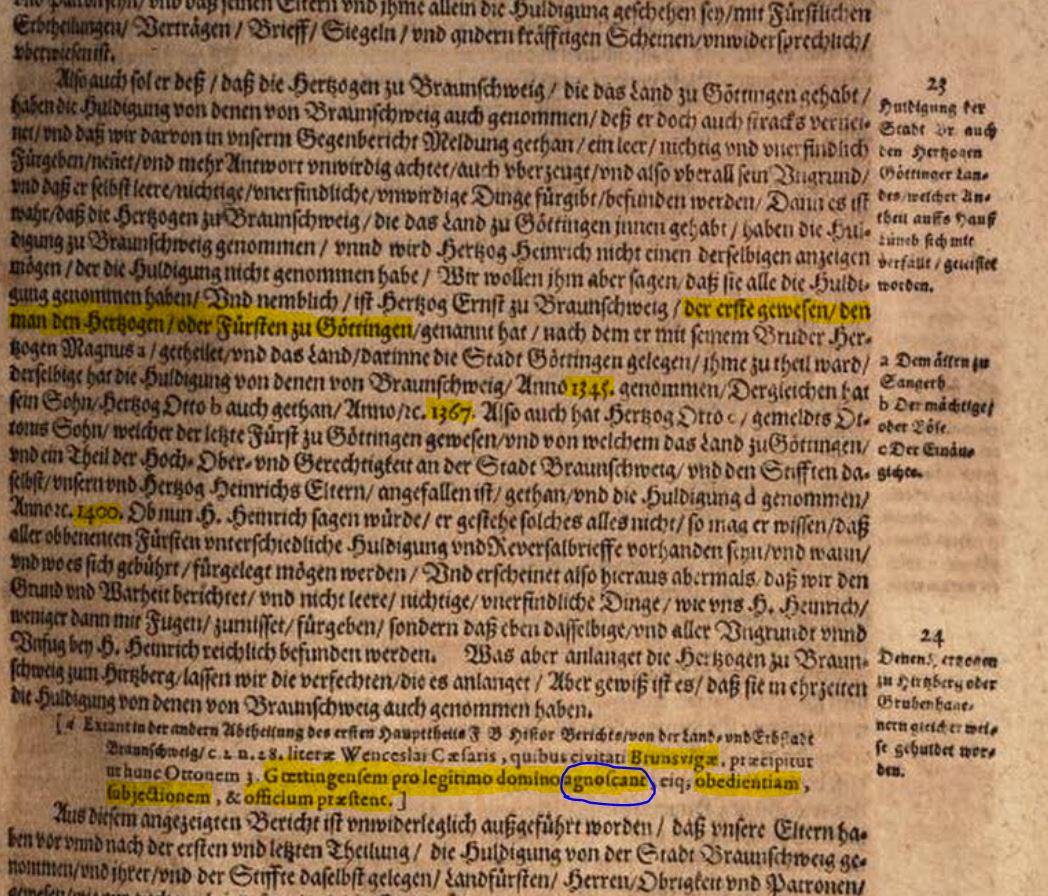
Odtąd „agnaci” [potomkowie rodu] nadal używają tego tytułu, zachowując prawo do posiadłości cesarskiego pałacu Gutingi. Państwo nadal legalnie jest dziś księstwem, choć tylko na mocy de iure rządu na uchodźstwie. Wszyscy prawowici potomkowie Brunszwiku rodzą się z tytułem „księcia Getyngi”, a tytuł „księcia Getyngi” nosi tylko główny książę Brunszwiku. Jako spadkobierca największej części dziedzictwa Billung w Saksonii, pałac cesarski w Getyndze wielu cesarzy był przez większość czasu odpowiednim aloidem dla Brunszwiku, dla rodu.
Herbem Księstwa Getyngi jest główny herb rodu Brunszwickiego, jak poniżej:
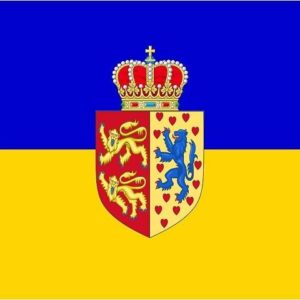 (Zwróć uwagę na Wolfenbuettel, ostatnią wersję de iure flagi, która była z białą i niebieską, a nie ze złotem. Złoto było jednak używane w starożytności i zamiennie).
(Zwróć uwagę na Wolfenbuettel, ostatnią wersję de iure flagi, która była z białą i niebieską, a nie ze złotem. Złoto było jednak używane w starożytności i zamiennie).
Stolicą Monarchii Brunszwickiej była przede wszystkim Getynga, w innych czasach była to podrzędna stolica drugorzędna niektórych mniejszych posiadłości w ramach większej Monarchii Brunszwickiej. Strategicznie miasto Brunszwik było przez pewien czas stolicą, a także księstwo Wolfenbuettel było przez pewien czas bardziej dogodną stolicą dla Wielkiego Brunszwiku-Lüneburga. Większość księstw podporządkowanych przez ostatnie 400 lat uznawało swoją podległość, pisząc swoje nazwy stanowe jako Wolfenbuettel-Luneburg [na przykład], co było kolejnym księstwem z wielu księstw podległych linii Wolfenbuettel głównej wyższej gałęzi rodu, który rządził wszystkimi jako Absolut. Monarchowie, który z definicji był również samym mikro-imperium i pozostał nim do dziś.
Korony cesarskie sięgają znacznie szerzej, niż można czytać, od Włoch po Rosję, aż po ostatnich panujących Piastów, choć wszyscy oni legalnie wymarli jako domy. Jednak wszystko, co możemy powiedzieć, o ile nasz starożytny i żyjący dom może zawsze wykazywać, wszystko wyrosło z tego centralnego dziedzictwa Gutingi / Gothian. Mnóstwo innych współplemiennych królestw, z którymi łączymy się dzisiaj ponownie!
More information on this living house is available from the Priory of Salem, Institute of Peace studies, if you write to the coadjutor at marshalofsalem@yahoo.com
Potomek królewskości Gothii na ziemiach turkusowych HISZPANII I FRANCJI (TERAZ LANGUDOK)
Wiele linii francuskiego królewskiego dziedzictwa Henryka Lwa pochodzi z czasów Gotów. Jednym z nich jest linia Guelphów, która pochodzi od starszego rodzica Karola Wielkiego. Być może jedną z najwyższych jest linia Argotty, matki wszystkich królów francuskich. Jest oficjalnie częścią francuskiej historii, więc włączymy ją później do osobnego rozdziału.
Nazwa, terytorium i dynastia Wizygotów pozostaje w tytułach szlachty Francji. Parostwo Francji (równi książęta o najwyższym stopniu rangi) ma kilku dziedzicznych książąt z tego królestwa, używając roszczenia jako większej prowincji zwanej „Languedoc”. Przeczytaj broszurę Jeana Lafitte'a i artykuł zatytułowany „Languedoc, déformation de * Land Goth?”. Dynastycznie jest również demonstracyjnie zachowany (jak podam poniżej). Sukcesja rodziny Wizygotów została zachowana z pierwotnej dynastii Balti za pośrednictwem wizygotyckiej księżniczki Brunhildy, babki Pepina (i innych wizygotyckich szlachciców), przenosząc w ten sposób prawa na Franków, później dynastycznych potomków znanych jako hrabiowie Tuluzy i książęta Gothii za dodatkowe 800 lat. Oryginalna kraina Gothia (Wizygotów) pozostaje pod nazwą „Langeudoc” (Kraina Gotów / Langue de Goth), zgodnie z licznymi autentycznymi zapisami, encyklopediami itp. Dziś można je również sprawdzić na dowolnej mapie. To, czy nazywają swoje terytorium Langeudoc czy Gothia, nie ma znaczenia, ponieważ wszyscy zgadzają się, że to to samo miejsce, to samo plemię i po prostu inna pisownia. Kontynuowano ją legalnie poprzez żeńską genealogię Wizygotów, także jako tytuł „Gothia”, a później potocznie ten sam region co Langwedocja. Przez większość pokoleń pozostawał w rządzie Toulouse Nobility. Następnie przeszedł na ich następcę Filipa III, który pochodził z wcześniejszej dynastii Kapetyngów, i przeszedł przez wszystkich królów francuskich do dziś. Wiemy, że Dom Burbonów, oddział kadetów z dynastii Kapetyngów, posiadał oryginalne dotacje o nazwie „Gothia”, zgodnie z książkami historii ogólnej (jeden jak na rysunku). Pierwotne terytorium dotarło do francuskich królów po przejściu od wizygockiej księżniczki Brunhildy. Przekazała go swoim spadkobiercom i królowi Merowingów Pepinowi, patrz: https://gw.geneanet.org/belfast8?lang=en&p=brunhilda+of+toledo&n=germany . Jak na załączonym obrazku, cała Gothia przeszła słusznie (prawnie) dynastycznie od Bernarda I do jego spadkobierców, aż do dnia dzisiejszego, w sposób konkretny. Nie tylko królowie chronili wszystkie takie tytuły prowincji, książęta i hrabiowie również nigdy nie wyrzekli się tego podmiotu prawnego znanego jako Langwedocja ani nie rozwiązali go w żaden sposób. Ich roszczenia do tego znamienitego przyzwoitości lub zrzeczenie się jakichkolwiek praw do tego podmiotu. To wszystko było już dawno rozstrzygnięte. Sytuacja stała się trochę chwiejna wraz z uzurpacją napoleońską podczas rewolucji francuskiej. Manifest z Brunszwiku miał przywrócić francuskiemu królowi wszystkie należne mu tytuły, których Napoleon odmówił. Dlatego też Brunswick dotrzymał wszystkich obietnic, jako naczelny wódz nad całymi Prusami, wódz naczelny nad całą Austrią i wódz naczelny (w czasie wojny) de jure France (zgodnie z udzielonym przez prawowitego króla Francji nadanie Brunswick dodatkowych uprawnień we Francji). Zwróć uwagę, że Brunswick ma również żywy tytuł Prince of Gettingen (Gothia) jako dziedzictwo dynastyczne, które pozostaje subksięstwem w księstwie Brunszwik i Lunenburg, z tym samym księciem wyższym (w czasie wojny) niż wszystkim trzem cesarzom. To zapoczątkowało wojnę o przywrócenie francuskiego króla pod wszystkimi oryginalnymi prawowitymi tytułami.
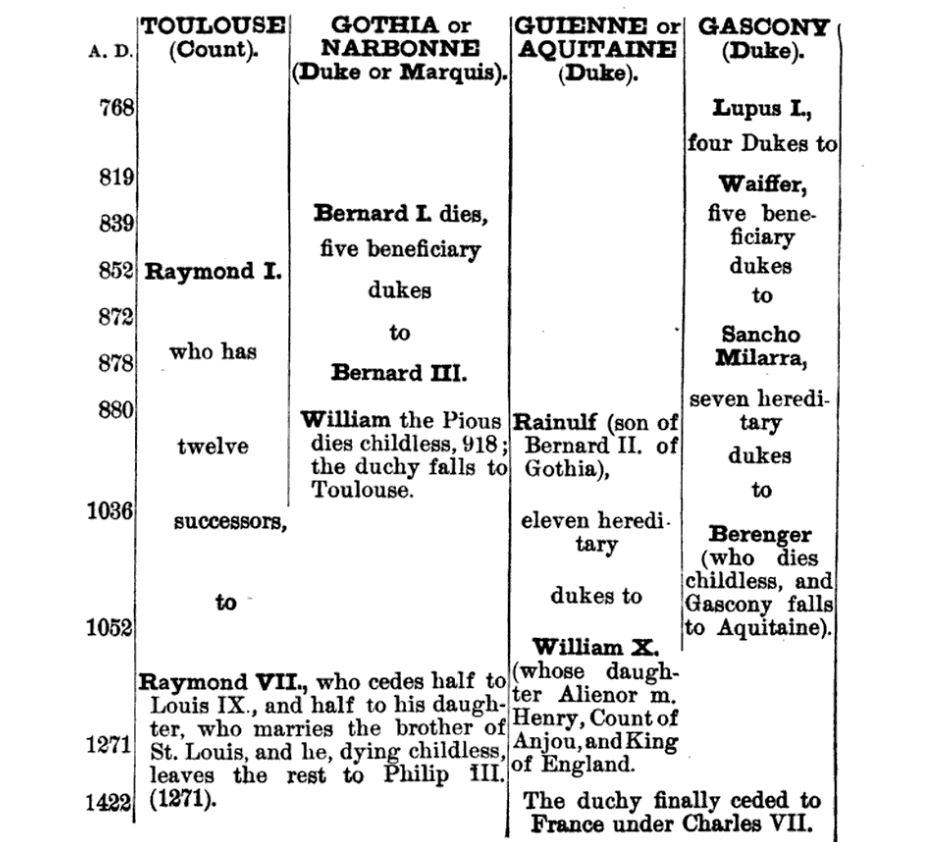
OSTATNI FRANCUSKI GOTYK KSIĄŻĘ, KTÓRY FUNKCJONALNIE UŻYWAŁ RODZINNEGO TYTUŁU GOTII, TYTUŁU, KTÓREGO WDZIEDZIAŁ OD SWOJEGO WRZOSOWEGO I DZIADKA, „KSIĄŻĘ GOTII” RAYMOND IV TULUZY, LIDER PIERWSZEGO KRZYŻA.
Cóż za wspaniałe dziedzictwo, które Goci odziedziczyli po Raymond IV, najpotężniejszym przywódcy Pierwszej Krucjaty.
Był spadkobiercą Królewskiego Domu Gothii jako „Princeps Gothia” oraz jako hrabia Tuluzy, książę Narbonne i margrabia Prowansji. Jednak tytuł „księcia Gothii” był przez wiele pokoleń ważniejszy dla jego ojca i dziadka, a także jego pradziadków.
Po swoim zwycięstwie wyzwalającym Jerozolimę i Bizantyjczyków,
Raymondowi zaoferowano koronę nowego Królestwa Jerozolimy. Jednak odmówił, ponieważ nie chciał rządzić miastem, w którym Jezus cierpiał. Powiedział, że wzdrygnął się na myśl o miano „Króla Jerozolimy”. Jest również prawdopodobne, że wolał kontynuować oblężenie Trypolisu niż pozostać w Jerozolimie. Jednak niechętnie zrezygnował z Wieży Dawida w Jerozolimie, którą odebrał po upadku miasta, i tylko z trudem Godfrey z Bouillon był w stanie mu ją odebrać.
Raymond wziął udział w bitwie pod Askalonem wkrótce po zdobyciu Jerozolimy, podczas której wojska najeźdźców z Egiptu zostały pokonane. Jednak Raymond wolał zająć Ascalon, niż oddać go Godfreyowi, a w wynikłym sporze Ascalon pozostał niezajęty. Krzyżowcy go zajęli dopiero w 1153 r. Godfrey obwinił go również za niepowodzenie jego armii w zdobyciu Arsuf. Kiedy Rajmund udał się na północ zimą 1099–1100, jego pierwszym aktem była wrogość wobec Boemonda, zdobycie Laodycei z Boemonda i zwrócenie jej Bizancjum.
TE DWIE LINIE, VISIGOTH I OSTROGOTH ZOSTAŁY ZJEDNOCZONE W OTTO IV, KSIĄŻĘ BRUNSWICK, KTÓRY BYŁ UKORONOWANYM CESARZEM ŚWIĘTEGO IMPERIUM RZYMSKIEGO
Te królewskie linie Wizygotów i Ostrogotów (dynastie Balti i Amali) zostały ponownie odświeżone w księciu Ottonie IV z Brunszwiku, który został koronowany na cesarza Świętego Cesarstwa Rzymskiego pod francuskimi herbami Brunszwiku i Akwitanii po stronie matki (Matylda). Obie strony rodziny jej matki miały rywalizujące roszczenia o sukcesję księstwa Tuluzy (Gothia). Ten herb Francji i Anglii pozostaje do dziś w Brunszwiku. W przypadku większości gałęzi Brunszwiku jest używana jako najstarsza wersja z dwoma lwami, a czasem z jednym lwem. Chociaż niektóre gałęzie, w tym przez pewien czas Otto IV, używały wersji trzech lwów.
Należy zauważyć, że jego matka była nie tylko rywalizującą następczynią Toulouse Gothia, ale także następczynią pierwszego założyciela Domu Templariuszy (Angevin / Anjou). Przez krótki czas Otton IV był spadkobiercą domu założycielskiego templariuszy, francuskiej szlachty Angevin (Anjou). Chociaż dziś żaden z francuskich spadkobierców nie jest znany z tej rodziny, wszyscy oprócz Brunszwiku. Jednak House of Brunswick to robi, ale rzadko przypomina Francji o tych prawach. Jedna z nich została przywołana w czasie wojny z Napoleonem. Jednak jako naczelny dowódca sprzymierzonych armii pruskich, austriackich i brunszwickich była tylko oferta pomocy prawdziwemu francuskiemu królowi w walce z gwałtownym socjalizmem rewolucji francuskiej. Oferta miała głównie na celu ochronę Jego Wysokości przed nadużyciami itp., Co powinien oferować każdy ważny i uczciwy władca. Ta oferta została ponownie rozszerzona na Napoleona III na mocy traktatu o pomocy Brunszwikowi w odzyskaniu wszystkich ziem niemieckich pod jednym imperium.
Ten Angevin i Toulouse (Visigothic) Templar przyszedł częściowo przez żonę Henryka Lwa Matyldę. Jednak znacznie więcej z tego pochodziło z własnej sukcesji rodu Billungów (Ostrogotów) Henry'ego.
Jako matkę cesarza Ottona IV rozpoznajemy go, a reszta jego braci była spadkobiercami Angevin (Anjou), Akwitanii i całej Francji. Otto IV wznowił tak wiele roszczeń Gothian, że jego następcy wprowadzili prawo do używania tytułu Prince of Gettingen / Gutingi. Ta dodatkowa gałąź francuska, wywodząca się z jego matczynego dziedzictwa, poszerzyła je znacznie dalej niż roszczenia genealogiczne Amelung Billings i linia Guelphic do Argotta i najbardziej szanowanego rodu gotyckich cesarzy.
MATKA WSZYSTKICH KRÓLÓW FRANCUSKICH, ARGOTTA I WCZESNEGO ODDZIAŁU GUELFÓW (BRUNSWICK SENIOR BRANCH)
The Frankish Kings absorbed and took over a major Gothian title for the part of France now known today as Langudoc. Many know prince Raymond IV of Gothia and Toulouse led the biggest armies of the 1st Crusade (and that he was equal peer of the King of France). Ever since the Frankish prince Alberici married Argotta, the daughter of Theodemir Amalaus King of Gothia, the sister of Theodoric Amali King of Gothia & Italy, and had a son Duke VAUBERTUS (or Wambertus) the title stuck and is in the official histories. Thus making him not only Heir of Gothia via his mother, but also the Grandson of the Sicambrian-Ukrainian descended Davidic King Pharamond on his father’s side (an established link in old Gothia Crimea where they still use the Gothic runes in their liturgy, it’s more similar to Greek letters). It’s also indisputed that the next in succession Gothian son Arnoldus founded the line of which Charlemagne is descended. The Guelphs (Brunswick House) is descended from the Grandaughter of Arnoldus, Princess Gertrude.
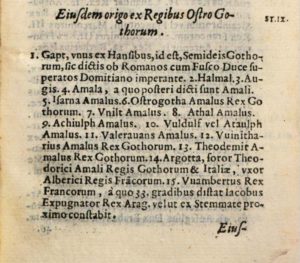
Ta fotokopia genealogiczna pochodzi z przedruku Testamentum Magni, Regis Norvegiae z 1628 r., Napisanego po raz pierwszy w 1277 r. –Judicium de scriptis Gasparis Scioppii contra Johannem Vossium et Famianum Stradam; –De Variis febrium generibus; –Praelectiones poeticae, 1674; –Conclusiones et decta Papae et Concilii Hispanici secreti, anno 1615 incepti, et usque ad annum 1627 perducti. Latine. Chartaceus, sec. xvii Quarto [11.247] (zgodnie z katalogiem w British Museum).
Genealogie, ponieważ odnoszą się do tych oficjalnych spraw suwerenności wielu narodów, były strzeżone jako jedne z najbardziej wiarygodnych informacji, jakie kiedykolwiek istniały. Narody sojusznicze zagwarantowały tę integralność w wojnach, aby chronić takie prawa do dziedziczenia genealogicznego itp. Obecnie mamy pewne międzynarodowe prawo, które nadal chroni nasze rządy na wygnaniu, w połączeniu z kilkoma traktatami międzynarodowymi. Genealogie można traktować jako jedne z najbardziej dokładnych informacji. Genealogia Chrystusa jest również jednym z przykładów, gdzie zapisy są dostępne i zostały wykorzystane do udowodnienia racji. Teraz powinniśmy równie dobrze jak to odnosi się do chrześcijańskiej własności i być dobrym szafarzem tego, co dał. Genealogie Andersona, opublikowane w 1732 roku, są powszechnie uznawane za absolutne. Jak opublikowano poniżej, widzimy, że linia ta powtórzyła linię Argotty od królów Ostrogotów i jej małżeństwo z Alberici, księciem Franków. „Matka wszystkich królów francuskich” będąca Argotta, nawet w samej nazwie mamy niezły dowód na boską sukcesję. Dom Brunszwik (Guelphs) jest z tego wczesnego korzenia. D'Este Guelph Brunswick-Wolfenbuettel-Oels, Senior Branch,…
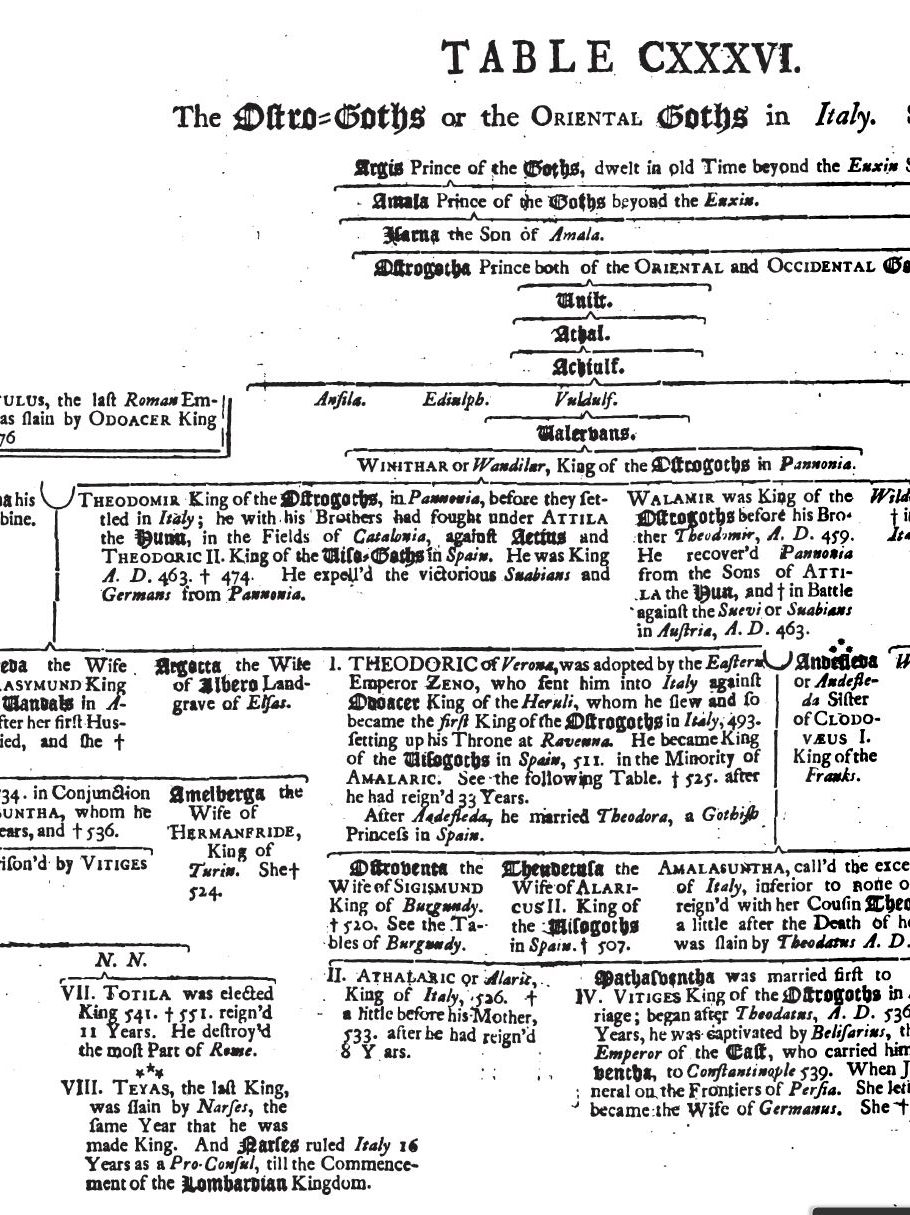
THE BALTI-GOTH DYNASTIC HEIRS
| Balti Goth Dynasty (Imp Gothia) |
| Theodoric I Balthas of Visigoths |
| Amalric
King of the Visigoths |
| Clodion, “le Chevelu”, King of France, son of Pharamond, King of France and Agotta, Queen, dau of Emperor Theodoric of Gothorum |
| Visigothic Princess Brunhilda + Sigebert I, King of Franks / Austrasia |
| Princess Chlodeswintha, dau of Sigebert & Brunhilda of Visigoths + Recaredo I King of the Visigoths |
| Bernardius Comte de Septimania, Margrave of Gothia, holding the independent allodial estates |
| Adalbertus, Duke of Alsatia (Alsace), son of Adalric, Duke of Alstatia, head of the Ethiconides, Major Domus of Allemania |
| Raymond IV, Prince of Gothia (Langudoc) Count of Toulouse, Provence and Narbone, peer/equal of the King of France. The head prince of the first Crusade, formed the earliest Knights Templar. |
| Matilda, Plantagenet & Angevin Princess of England, Normandy, Anjou, and Aquitaine, Head of Gothia Langudoc + Henry the Lion of Brunswick, Duke of Saxony and Bavaria |
| Emperor Otto IV, Duke of Brunswick, From 1196 was Duke of Aquitaine which covered most of France, incl Gothia / Langudoc, Was King Richard made him chief successor of the entire Angevin Empire(Britain, France, Jerusalem etc), withheld by the competing Capet line. 1197 crowned King of Germany, also King of Burgundy, Crowned Holy Roman Emperor 1206 |
| Emperor Frederick I Duke of Wolfenbüttel-Brunswick, Crowned King of Germany, Holy Roman Emperor |
| Wolfenbüttel Mini-Emperors. The ‘elder-branch’ Successors continually Emperors of states across the continent with continued Military rank higher than Emperor as Commander-in-Chief of Prussia, Austria, Poland, France, Senior branch over Hanover etc. Cont’d claim of estates linked with the “greater domains”. |
SUKCESJA GOTYKA I SUKCESJA IMPERIALNA
W tym temacie nie można nie wspomnieć nie tylko o tytułach księcia gotyckiego, ale także o licznym dziedzictwie krwi aloidalnej posiadłości cesarskich ostatnich cesarzy z kilku starożytnych rodów, które przeszły do tego rodu.
Tak wiele posiadłości aloidalnych rodzin cesarskich przeszło w ręce jedynych męskich spadkobierców (Brunswick d'Este-Guelph). Jest to kolejne świadectwo tego, że jest to wielki Boski dar, jak zawsze nazywamy „z łaski Bożej”. W tym samym czasie, kiedy królewska dynastia rodu Gotów została pomyślnie przekazana i dziedziczenie przez ród Brunszwików w Henrym Lwie d'Este-Guelph, było czasem cesarskiej sukcesji. Te sukcesje nie tylko pochodziły z tego okresu od 900 do 1200 roku z cesarzem Ottona IV z Brunszwiku, ale trwały znacznie dalej.
W 1400 roku książę Wolfenbuettel-Brunswick Fryderyk został wybrany cesarzem,
W XVII wieku ostatni rodowód Piastów był kontynuowany przez Brunswicków,
W połowie XVIII wieku inny książę Wolfenbuettel-Brunswick Iwan VI został cesarzem całej Rosji.
Było już tak wiele linii cesarskich (z których żadna rody Habsburgów lub Prus nie mogą rościć sobie pretensji, ponieważ ich krew była tylko hrabiami, nowszych rodów). Jednak rodzice i dziadkowie Henryka Lwa, którzy byli cesarzami, przekazali prawa krwi Imperium do tej linii, ponad wszystkich innych.
Chociaż linia ta należała już do najwyższych królestw (tj. Pierwotnej większej Saksonii, księstwa od czasów Henryka Lwa i starożytnych królów Saksonii), często była ona wstrzymywana przez de facto cesarzy. Cesarz Lothar III (czasami nazywany Lothar II) z Supplingenburga nadał ówczesnemu szefowi rodu (d'Este-Guelph), Henrykowi Dumnemu, pełną sukcesję na cesarza. Cesarskie rządy Henryka 1137-38 obejmowały „od morza do morza, od Danii po Sycylię”, jak chwalił się jego biskup Otto von Feising.
Edycja cesarza Lothara o sukcesji Henryka również rozszerzyła jego terytoria i obejmowała transmisję insygniów imperialnych (Reichskleinodien).
Ta sukcesja była rozumiana przez dziesięciolecia i stanowiła warunki całego panowania Lothara, dla poparcia kilku książąt prowincjonalnych Saksonii. Można prześledzić, że to poparcie, nawet od jego wyboru aż do śmierci, było zapewnione jedynie przez małżeństwo jedynej córki cesarza z synem Henryka. Cesarz Lothar miał swoje jedyne dziecko, Gertrudę, poślubioną synowi syna Henryka Czarnego Henryka Dumnego. Bez tego małżeństwa jego własna cesarska sukcesja nie zostałaby uznana przez licznych książąt z dóbr Henryka.
From long before that time, up until today, the House of Brunswick has remained a the oldest living and most senior Imperial house of Germany(incl. beyond German borders), with an equal right to be elected to the throne of Emperor. This is of the original Reich of Charlemagne, under it’s laws which required unbiased voting for an Emperor that only holds that rank during war time. Afterwards is to go back as an equal prince. This mode was how Brunswick continued to operate, and was still often called to be commander-in-chief at times of great wars. The original order had been long usruped by the likes of the Hapsburgs and Prussians. From the inception of such illegal actions it has been met in the fields of battle and has continued even to this day, as shown in the existing treaty of Ham that the current head of House has rights to claim to exercise a right as Emperor of all German lands. The rights to all these estates have continued long since the Guelph and Ghibelline wars/rivalries, and the original stealing of 90% of the estate known as the Duchy of Saxony, of which is still contended for (from Eastphalia to Westphalia etc as the True Saxony borders) and is in the main coat of arms of the house (the coat of arms of the last King of Saxony). For much of the time this senior house has had wars with the current usurpers, Habsburg who have not done true valid elections, where all princes would have an equal chance to be Emperor. So the senior branch of (Wolfenbuettel)Brunswick refused to be electors, unlike the junior branch of (Hanover)Brunswick. Wolfenbuettel-Brunswick maintained seniority in the general college of princes. None of the college of princes nor the electors of the time would recognize Hanover’s illegal creation as a new elector(just to make more votes for Hapsburg, their only supporter). For much of the time till the destructions of Napoleon, the Brunswick’s held title of “Commander-in-Chief” over the entire Empire, a rank higher than the Kaiser in time of war. Multiple dukes held this title also during the war with Napoleon, as in previous centuries over the larger bodies of the Germanic nations. So in practice still the claim had remained somewhat recognized.
The Angevin territories (Britain, France and Jerusalem) were also inherited by the House of Brunswick, although has been in a rival dispute ongoing with the Capets. Several of the alloids of the House of Brunswick continue in the house as being older than the Carolingian Empire itself, still ongoing in a chief Imperial bloodline.
Brunswick-Gottingen (named after the Saxon King Witukind’s Danish wife and her line of Gothia Denmark-Sweden) was the allodial capital for the older Saxon Emperors of which the dukes of Brunswick descend. The transmission of the Imperial mantle continued from one Saxony duke to the next, Otto IV of Brunswick. Henry the Lion’s son, Otto IV von Brunswick also wore the Imperial insignia that was originally belonging to the house, when he was officially crowned Emperor, and recognized worldwide. There was one condition from the pope, that he would not retake the family’s possessions of Sicily. He broke that promise and for that reason was excommunicated, however the family from that day, till today has never abdicated this right and title of right to be Emperor, nor the titles that are most foundational of the Empire, as Europe’s oldest and most senior living Royal family (in legal international and prescriptive law).
SZWEDZKI I DUŃSKI DOM GOTII
Dziś (do 1972 r.) Dom panujący Duńczyków (House of Glucksburg) używał tytułu King of the Goths.
To nazewnictwo Gothia sięga czasów starożytnych. Cały tamtejszy obszar, Dania i południowa Szwecja, nazywają się Gothia. Miał również podział na własną Ostrogotię i Westrogotię, itp. Chociaż granice te często się zmieniały, nadal rozumiano, że ogólna nazwa regionu to Gothia (i wielu historyków pisało Geats, porównując je z Samogetią i plemionami wokół Łotwy i w dół do Billunger ląduje Westerward wokół Luneburga).
The Swedish Goths and Danes were some of the greatest kindred allies of the House of Brunswick (especially loyal after Henry the Lion’s wars against various tyrannical German Emperors). Generation after generation of marriages continued with the Kiev Rus Vikings that were entertwined with the Danish Goth Royals.
One such marriage (Otto I the Child, to Princess Helena of the Danes) was contracted during the tumultuous period of the forced re-creation of Brunswick-Luneburg. Several gifts of the realm of Gothia were given from the King of Denmark to Otto. The re-creation of Brunswick however was accomplished by a trickery when Duke Otto the child, under duress was forced to “voluntarily” part with the Dynastic realms of Greater Saxony, of Italy, and the eastern Goth lands such as Pomerania where all would be returned back as one fief of the Empire. In 1235 he was forced to rename his vast domains into a re-consolidated Dukedom of Brunswick-Luneburg. Many have eroneously reported that this limited the domains of Brunswick. While it may appear limiting on it’s face, this was only as it stood within the Holy Roman Empire (HRE) jurisdiction, while Brunswick continued itself as an Empire across the continent. It was common that Dukedoms operated as the highest form of an Empire in parallel to the HRE, as other ducal Monarchies operated, such as the “Hapsburg Empire” with numerous subordinate principalities and other vassals. Hapsburg, like other houses of great Empires, had no higher rank than Dukes in the HRE (as dukes were higher than princes in German law). For Brunswick this claim was just as great, and arguably continued on greater than Austria in many respects. The post-1235 domains included several principalities, and succession rights in at far corners of the continent, with all states continuing their subordinations and loyalties as vassals of his house.
The Luneburg house (subordinent principality and alloid of the Dukedom) is most well known as a descendant branch of the House of Gothia. It is so visibly near to the region that is known to the name Gothaland, and holds the same coat of arms of that land as the primary shields of Brunswick-Luneburg.
The coat of arms for the Luneburg principality itself bears witness, with the design of the blue lion and hearts having it’s history as the main arms of Scandinavian Gothia, also while it was the primary house of the Kiev-Rus. Smaller provinces of Gothia would have less than 3 Swedish or Danish lions. We see this heraldry reflective in states also under subordination of Brunswick, such as Holstein, and from which the family descends in Schleswig and Glucksburg. This unmistakable symbol of the Gothis region of Scandinavia is the Blue Lion on the golden background, with the red hearts.
Genealogies tied to the arms are also most forthcoming within the house of Wolfenbuttel-Brunswick and it’s ancestors.
A major Gothian line of Brunswick goes back to Wulhild of Saxony, the daughter of Olaf II, King of Norway. Her mother was of the Royal House of Gothia. A chart has been put together as follows:
YNGLING-GOTH DYNASTY HEIRS
| Yngling Dynasty (Emperors/Kings of Scandinavian Gothenland) |
| Froda or Frey called Yngve |
| Gotharus Ottar Vendelkråka |
| Erik VIII the Victorius, King of Sweden
+Sigrid, Queen of all Gothenland, dau of Viking Skoglar Tosti (and Mother of Knut the Great) |
| Olaus Skötkonung
King of Gothia |
| Astrid Olofsdotter, Princess of Gothia
+ King Olaf II Harldsson of Norway Rex Perpetuus Norvegiae |
| Wulfhild of Gothia, Sweden and Norway + Ordulf Billung of Saxony |
| Emperor Henry the Proud of Brunswick, Ruled the Baltic to Sicily |
| William of Winchester, son of Henry the Lion. Brother of Emperor Otto IV, Duke of Brunswick, King of Germany, Crowned Holy Roman Emperor |
| Otto the Child, successor of Brunswick, in Denmark was made count of Garding and Thetesbüll in Schleswig Holstein as a Danish prince through his mother Helena Regent, princess and duchess + Ascanian Mechtild/Matilda of Brandenburg Ascanian Billunger Saxony |
| Emperor Frederick I Duke of Wolfenbüttel-Brunswick, Crowned King of Germany, Holy Roman Emperor |
| Wolfenbüttel Mini-Emperors. The ‘elder-branch’ Successors continually Emperors of states across the continent with continued Military rank higher than Emperor as Commander-in-Chief of Prussia, Austria, Poland, France, Senior branch over Hanover etc. Cont’d claim of estates linked with the “greater domains”. |
Otto the Child himself was descendant of this branch of Gothia, and of the Kiev Rus, and of the French Visigoth branches. Then his mother being the Danish princess gained him more rank in Gothia. He went in league with his uncle Valdemar II, King of Denmark. For his mutual support in war, Otto was made a Count of Schleswig (Sweden/Denmark Gothia).
Otto the Child’s mother was herself born into the Danish Royal house, long ruling the primary region of Gothia. Her father was King Valdemar I of Denmark, who was the son of Canute Lavard, Duke of Schleswig and his mother was Ingeborg of Kiev(daughter of Grand Prince Mstislav I of Kiev and Christina Ingesdotter of Sweden).
So the House of Brunswick also has this interesting Viking-Goth background of their ancestress, Helena of Denmark (a Duchess of Brunswick-Luneburg). Not only her paternal line was impressive, but also her maternal line: her mother was Sophia of Minsk, of the Rurikid Dynasty, as daughter of Volodar of Minsk and Richeza of Poland.
This is where half of the coat of arms of Wolfenbuttel-Brunswick comes from, the living Royal and Imperial House of Germany (cadet successor branch of 1935, a de jure house in exile).
CIĄGŁA OCHRONA KRYMSKIEJ GOTII
Prawdopodobnie jeden z najstarszych, a jednocześnie jeden z najnowszych, którzy używali tytułu „księcia Gothii”, przebywał na Krymie. Należy zauważyć, że Gwelfowie od dawna utrzymują szlachetnych przedstawicieli na dworze Gothii w Caffie. Tak było przez okresy Caffa była częścią kolonii Genui, republiki gulefickiej.
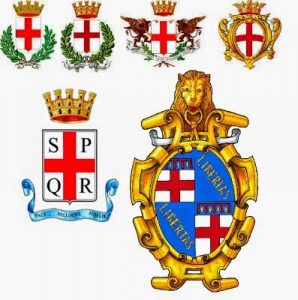
Krzyż heraldyczny Guelph, będący Czerwonym Krzyżem na białym tle, był nie tylko herbem Genui, ale można go znaleźć na herbach miejskich tradycyjnych miast Guelph, takich jak Mediolan, Vercelli, Alessandria, Padwa, Reggio i Bolonia.
Niektóre osoby i rodziny wskazywały przynależność do frakcji w swoich herbach, włączając odpowiedniego wodza: Guelphs miał capo d'Angio lub „wodza Anjou”, złote fleurs-de-lys na niebieskim polu, z czerwoną etykietą heraldyczną ”
Tarcze miejskie są świadectwem historii zmagań między Guelphami (Templariuszami) a Gibelinami (Szpitalnikami). Każdy ma odwrotną tarczę krzyża. Te dwie walczące frakcje Imperium były zaciekłymi rywalami o cesarski tron Świętego Cesarstwa Rzymskiego.
Podczas gdy różni papieże ogłosili prawie tuzin krucjat przeciwko Turkom, zwłaszcza na Caffa Crimea, bardzo niewielu przyjęło to wezwanie. W książce „The Colonies of Genoa in the Black Sea Region”, autorstwa Khvalkov, s. 225, jest napisane, że w biskupstwie Caffa, Gothia, Guelphs byli uważani za szlachciców i utrzymywali szlachetnego przedstawiciela Guelph na Krymie, ale w przypadku Ghibelline (lub innego Wenecjanina) nie wymienia ich jako Szlachetnych przedstawicieli.
Dziś młodsze podchorążowskie oddziały Este dominują w tej części Włoch. Jednak starszym oddziałem Este Guelph jest Brunswick Wolfenbuettel. Pozostało to wieczystym roszczeniem domu, uznanym przez wszystkie strony.
Ten sam dom złożył petycje do ambasady rosyjskiej i ukraińskiej o porozumienie pokojowe, zanim zbyt duży rozlew krwi wydał się podczas pokojowych protestów w Kijowie w latach 2013-2014. Pierwotna propozycja pokojowa zawierała warunki oddania Krymu pod kontrolę Domu Nott-Brunswick-Wolfenbuettel. W dokumencie głównym roszczeniem do ukraińskich praw wyborczych był fakt, że strona Nottów ma kilka linii do pierwotnego domu założycielskiego szlachty ruskiej. Jedna z tych linii została udokumentowana w korespondencji.
Dom Brunszwik pozostaje również związany z sukcesjami księcia biskupów krymskiej Gothii. Obejmuje to obecnego arcybiskupa Gothii na Krymie i kilku ich diecezji.
+ Ambrose von Sievers, z Metropolitanate of Gothia jest biskupem Prawosławnego Kościoła Prawosławnego (Russian Catacomb Church). To kolejny kościół, który uniknął prześladowań bolszewików i ich kolejnych agentów. Jego kościół jest uważany w niektórych kręgach za niekanoniczny z powodu odmowy poddania się kościołowi zainstalowanemu w KGB. Ponieważ uciekający biskup andrewicki dokonał kanonicznej konsekracji + Ambroży, uważa się, że kościół Gotów jest naprawdę kanoniczny, w przeciwieństwie do wielu innych jurysdykcji. Jednak prześladowania trwały nadal, ponieważ duchowieństwo było atakowane i zabijane w ciągu ostatnich dwóch pokoleń.
KIEV RUS GOTH DYNASTIC HEIRSHIP
|
||||||||||||||||||||||||||||||||||||
| Brunswick remained peer of Russia. co-protections remained with all Russian Monarchs. According to the primogeniture succession law 1797 re-established by Paul I of Russia, the Senior house of Wolfenbüttel-Brunswick are rightful heirs in Russian (and Dynastic, and international) law…
By numerous guarantees of Russian law, Russian Dynastic law, and Brunswick Dynastic law, and intl. treaties, these Russian estate titles of Romanov-Wolfenbuttel-Brunswick passed to the head duke of Brunswick in 1764. Charles I of Brunswick had multiple sons fighting against the illegal Russian regime in the wars that followed the murder of de jure and de facto Emperor Ivan VI von Wolfenbuttel-Brunswick in 1764. The last reigning de facto and de jure duke of Wolfenbuttel-Brunswick Charles II, was Nephew of the reigning Tsar of Russia. In multiple edicts placed death penalties on those who sought to divide his primogeniture hereditary estates, including those outside of mainland Europe. de jure princes of Wolfenbuttel Brunswick (from Ulric de Civry Wolfenbuttel forwards) include the cadet branch of the natural family that were not divorced from the natural family in edicts of Charles II. |
||||||||||||||||||||||||||||||||||||
ROYALTY OF HUNGARIAN GOTH ESTATES, AS PIAST & POLAND-LITHUANIAN SUCCESSORS
Plik Piast successor lines of Brunswick culminated also in the Royalty of Hungary who were the house of Angevin. The then successive rulers had claims in the realms of Transylvania, Wallachia, Moldova, and other original alloids of the Goth Nobility.
A senior Polish prince Vladislaus II had become King of Bohemia, and after having succeeded Matthias Corvinus in 1490, he also reigned as King of Hungary. Although King of Hungary, still Silesia and Moravia was retained in the hands and titles of the Corvinus family.
This line of Piasts, descendant of the Polish, Hungarian and Angevin Imperial lines, had passed down the succession of the house with the successors of Munsterberg, in Wurtemberg-Oels for Centuries. Finally when that (Württemberg) male line became extinct in 1792, it went as per the original Piast House law, that the Piast inheritance can pass by choice, and by female branches. So it passed to the last daughter and heiress Sophia Frederica Charlotte, to her husband, who upon his death passed it to his Heir, Duke Frederick William of Brunswick, from whence has continually been in the House of Brunswick-Wolfenbuettel which do this day maintains a valid status in international law as a de jure principality of the Brunswick-Wolfenbuettel-Oels government in exile.
This Silesian (and Griffin) Piast family name of Oels and coat of arms are continually used by the House of Wolfenbuttel-Brunswick, as the chief bloodline heirs of this branch. The heirship continued although there have been many occupations, including by Prussia. The occupations and usurpations have always been met with the strong legal protests, affirming the estates remain for the heirs pursuant to public, dynastic house law, treaty and international law.
The most Piast bloodlines, more than any other house culminated in the House of Wolfenbuttel-Brunswick. The only blood heir, and also the last Piast alloid principality in possession of any other monarch is known as “Oelsnica” (also the last residence of the sovereign Prussian Kaiser, during the occupation of Wolfenbuttel-Brunswick). It is retained with perpetual claim, and is used in the family name and coat of arms. Therefore several de jure sovereignty rights are preserved for Poland’s oldest Royal House and domains. The House of Wolfenbuttel-Brunswick (and by the House of Saxony) continues to maintain these basic requirements in international law.
One Piast line that founded the present bloodline of the House of Wolfenbuttel-Brunswick more here:
| Piast Imperial Dynasty (Silesian Piast Alloids and Ascanian Pomerania) |
| Bolesław I the Brave, King of Poland, Ruling Duke of Bohemia |
| Bolesław III Wrymouth Duke of Poland Silesian Piasts, Elder Branch of Piasts |
| Konrad I of Masovia, High Duke of Poland |
| Emperor Casimir III the Great, King of Poland, King of Russia |
| Emperor Louis I, King of Hungary and Croatia, King of Poland. House of Anjou(Father) and Piast (Mother) |
| Queen Jadwiga of Poland Piast – Anjou, Princess of Hungary, Grand Duchess of Lithuania, founding the Polish Lithuanian Monarchy |
| Philip II, Duke of Pomerania-Stettin (Griffin Piast and Wolfenbüttel) |
| Henry V of Wolfenbuttel, son of Henry IV and Griffin Piast Katerina of Pomerania
+ Sophia Jagiellon, Regent of Jerusalem, Duchess of Wolfenbüttel. |
| George IV William, last male of the “elder branch” Silesian Piasts |
| Clara Maria, Duchess of Pomerania, dau of Clara of Brunswick-Lüneburg, last Griffin Piast
Royal Marriage to Duke August II, of Wolfenbüttel, founder of senior branch Brunswick Wolfenbüttel |
HISTORICAL AND NEW DYNASTIC CHARTS OF THE HOUSE OF WOLFENBUTTEL-BRUNSWICK
A full chart of the Imperial lines of Dynastic succession (with several ongoing living estates and domains) is available. This presents what is supported in accepted international laws of recognition, in the family Dynastic laws concerned, in several aspects of international law and rules of prescription etc. More is available upon request by writing to marshalofsalem@yahoo.com or within the book now available on request from www.wolfenbuttel.info lub www.vonbrunswick.com (copyright 2008-present).
The membership communities of the Gothian Empire have a strong cultural and ethnic basis whose people lost their right of self-determination and freedom of association for some time. The Priory of Salem, Institute of Peace Studies offers the support we have in Jesus Christ, who with the Father and the Holy Spirit helps this neglected people to find a higher sense of value, above that which the present world system offers. Our historic areas, our institutions, and aspects of our culture still bear their names of their Gothic origins today. The Bible tells us “look to the rock from whence you were hewn”. We find much encouragement as we trace the cultural heritage out to see God fulfiling the destiny of His covenant Christian people. Many of the surrounding studies of this House and parallel order, including our House Orders, and Templar Order, is found on our blogspot. The maps of the Gothia parallel Empire states is available on request, but much information is privileged for members only. A first step would be to fill in an application at https://St-AndrewsOCC.org and begin your mission to greater inner peace and satisfaction, through the encouragement of all God has provided to the body of Christ (His people) and their continuing order for their own people (religious, spiritual, priestly and royal).
PRINCE STEPHEN, ANOINTED AS A KING (of one jurisdiction of the many Goths’ states) OF THE GOTHS AT A BERLIN CEREMONY IN 2015
At a ceremony held by the Orthodox Church Western Rite Metropolia at Berlin, Stephen d’Guelph Brunswick was anointed as a titular King of the Goths(only one of many local Gothia jurisdictions), as an Emperor Elect, and as a Prince-Elector (an equal Elector on the Gothian Empire) high prince of his local jurisdiction (Benelux), at the formation and constitution signing for the re-founding of this order. http://gothiantemplar.blogspot.nl.
- House of Brunswick European Imperial Restoration Gains Popularity in Germany, France, Poland and Ukraine
- Brunswick Continuing Knights Templar House of the Original Angevin Royals’ branch, with full Royal protections of the Templar, incl. fons honorum
Other jurisdictions of the Goths also have (as demonstrated) had their own Kings of Goths at their local region. As Electors these titles may vary but are typically “Prince-Elector” and may hold dual local titles. In this case as a Brunswick heir of the local jurisdiction for the church which included various tribes, such as the Burgundian Goths. His forefather Otto IV von Brunswick was also King of Burgundy. So this title was most appropriately placed for this particular jurisdiction of Goths (at Benelux) and put into the founding charter documents co-signed by six other Imperial Electors. The election was set 10 years prior in official documents. The rank of Emperor can only become effective when there are twelve aethelings electing him (voting) for his rotation to head a true Germanic Imperial Diet. This is the ancient way which always ran parallel to the Holy Roman Empire.
Heirs of other Gothian States who can claim some form of de facto or de jure inheritance are also welcome to join our wider tribal order. The traditional and cultural representation of our Gothian States is in vital need of rekindling. The cultural representation in Brunswick, spanning more than 1,000 years is one valuable aspect of our order. The states include regions anywhere in the world where there is some kinship to the tribes of the Goths. As Brunswick has held a flag in most corners of the earth, including Australia, Canada, South Africa, etc, the tribe’s representation may be lacking. This ceremonial order for the local region may help booster morale and encourage more development of our cultural Christian civilization. The working together and having our own system and economy is important for our future success as a smaller tribal people.
The Templar of Gothia jurisdictions was then founded as an independent Order. Each Imperial Elector was automatically made a Grand Commander of their local jurisdiction. Gothia jurisdiction is not required to join the Templar but it is one of many options. Such as the Brunswick Order of Templar Portugal’s order etc. If it’s not with a Royal protector that has true sovereignty, then we can’t fully endorse them as knights, but would offer to integrate them into either order to gain this valuable level of Royal protection of international sovereignty within the Brunswick jurisdiction lub Gothia jurisdiction.
militie templi iurisdictiones gothorum imperii
Knights Templar of Gothia. As established by the Prince of Gothia in 1099 under his kinsmen, the first 11 Angevin Kings of Jerusalem, and consecrated between hands of the Patriarchs of Constantinople and Jerusalem. Inherited by Wolfenbuttel-Brunswick, represented by Imperial Knights of Gothia, in allegiance to the Dynastic Heirs of the Angevin and Gothian House. With the aim to advance the Christian religion, restoring Jerusalem, and protecting our pilgrims as they worship at our holy sites.
DODATEK
Pieczęcie cesarza ottońskiego (używane dziś w heraldyce Brunszwiku)
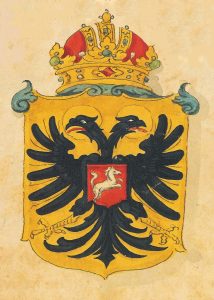

Pieczęcie Ottona IV z Brunszwiku
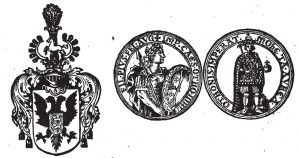
Książę Otto z Brunszwiku, cesarz Świętego Cesarstwa Rzymskiego
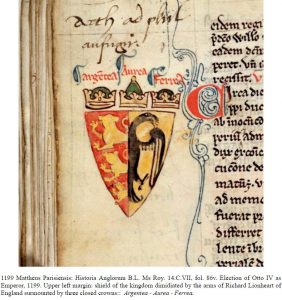
Cesarz rosyjski Iwan VI Brunszwik-Wolfenbuettel-Romanow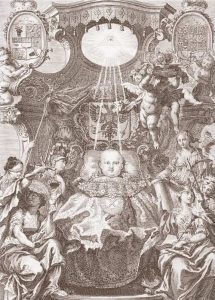
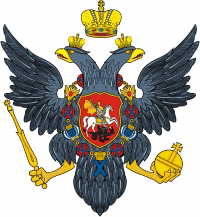
Więcej artykułów na ten i pokrewne tematy można znaleźć pod adresem celticorthodoxy.com
Praise YAHWEH every day for each victory as we do as Jesus Christ told us to pray, and to ordered us to “seek first His Kingdom law governance on earth”. May Jesus Christ soon come back to find us worthy to be His subjects, vassals, princely true Israel Nationalists, and thengs, at His Jerusalem government when He shall reign as King of kings and our Lord of lords.
This article is a mere sampling of the upcoming book to be made available at http://wolfenbuttel.info http://www.vonbrunswick.com (Copyright 2008 – Present).
Subscribers will have continued public service updates that include highly informational videos (now mostly for members only). You’ll learn how to get involved at local levels, as well as to vote and seek the self representation, self determination and freedom of association at is enshrined as a human right everywhere in the world (and is now the least claimed, but vitally important for future peace and prosperity).


